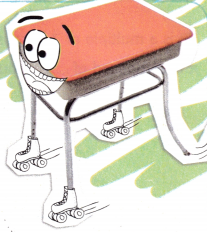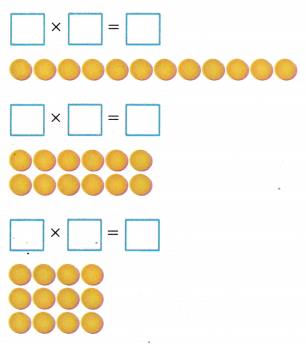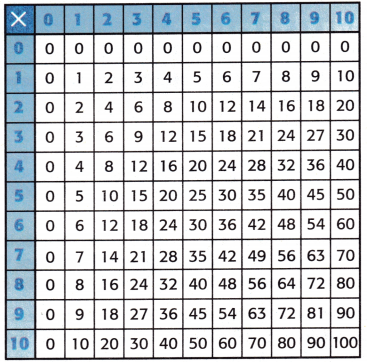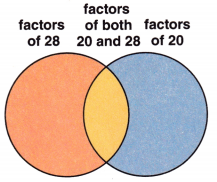All the solutions provided in McGraw Hill Math Grade 4 Answer Key PDF Chapter 3 Lesson 7 Factors and Multiples will give you a clear idea of the concepts.
McGraw-Hill My Math Grade 4 Answer Key Chapter 3 Lesson 7 Factors and Multiples
Math in My World
Example 1
Mrs. Navarro is arranging desks in her classroom. There are 12 desks. How many ways can she arrange the desks so that the number of desks in each row is the same?

To find the different arrangements of desks, break down or decompose 12 into its factors. Think of factors that result in a product of 12. Use factors to write a number sentence for the arrays shown.

The factors of 12 are ____, ____, ____, ____, ____, and ____
So, the desks can be arranged in ____ ways.
Helpful Hint
There are three more possible arrays:
12 × ![]()
6 × ![]()
4 × ![]()
Answer:
Given that,
The total number of desks are 12.
12 desks are arranged in

The factors of 12 are 1, 2, 3, 4, 6 and 12.
So, the desks can be arranged in 3 ways that are
12 x 1 = 12.
6 x 2 = 12.
3 x 4 = 12.
Example 2
All of the numbers listed in Row 7 or Column 7 are multiples of 7. Shade the multiples of 7 on the chart. The first five multiples of 7 are 0, ___, ___, ____, and ____
28 is a multiple of 7 because it is composed of ___ groups of ____.

Answer:

The first five multiples of 7 are 0, 7, 14, 21, 28.
28 is a multiple of 7 because it is composed of 7 groups of 4.
Talk Math
Explain how factors and multiples are related.

Answer:
Factors are numbers which divide the numbers exactly. where as the multiplies are numbers which are multiplied by the other number to get the specific number.
Guided Practice
Find the factors of each number.
Question 1.
6
________
Answer:
The factors of 6 are 1, 2, 3 and 6.
6 x 1 = 6.
1 x 6 = 6.
3 x 2 = 6.
2 x 3 = 6.
Question 2.
36
________
Answer:
The factors of 36 are 1, 2, 3, 4, 6, 9, 12, 18 and 36.
1 x 36 = 36.
36 x 1 = 36.
4 x 9 = 36.
9 x 4 = 36.
12 x 3 = 36.
3 x 12 = 36.
18 x 2 = 36.
2 x 18 = 36.
6 x 6 = 36.
Identify the first five multiples.
Question 3.
4
________
Answer:
First five multiplies of 4 are
4 x 1 = 4.
4 x 2 = 8.
4 x 3 = 12.
4 x 4 = 14.
4 x 5 = 20.
Therefore first five multiplies of 4 are 4, 8, 12, 14, 20.
Question 4.
9
_________
Answer:
First five multiplies of 9 are
9 x 1 = 9.
9 x 2 =18.
9 x 3 = 27.
9 x 4 = 36.
9 x 5 = 45.
Therefore the first five multiplies of 9 are 9, 18, 27, 36 and 45.
Independent Practice
Find the factors of each number.
Question 5.
4
Answer:
The factors of 4 are 1, 2, 4.
1 x 4 = 4.
4 x 1 = 4.
2 x 2 = 4.
Question 6.
7
Answer:
The factors of 7 are 1, 7.
1 x 7 = 7.
7 x 1 = 7.
Question 7.
14
Answer:
The factors of 14 are 1, 2, 7, 14.
1 x 14 = 14.
14 x 1 = 14.
2 x 7 = 14.
7 x 2 = 14.
Question 8.
28
Answer:
The factors of 28 are 1, 2, 4, 7, 14 and 28.
1 x 28 = 28.
28 x 1 = 28.
2 x 14 = 28.
14 x 2 = 28.
7 x 4 = 28.
4 x 7 = 28.
Question 9.
30
Answer:
The factors of 30 are 1, 2, 3, 5, 6 10, 15, 30
30 x 1 = 30.
1 x 30 = 30.
2 x 15 = 30.
15 x 2 = 30.
3 x 10 = 30.
10 x 3 = 30.
6 x 5 = 30.
5 x 6 = 30.
Question 10.
35
Answer:
The factors of 35 are 1, 5, 7, 35.
1 x 35 = 35.
35 x 1 = 35.
7 x 5 = 35.
5 x 7 = 35.
List the first five multiples.
Question 11.
1
Answer:
First five multiplies of 1 are
1 x 1 = 1.
1 x 2 = 2.
1 x 3 = 3.
1 x 4 = 4.
1 x 5 = 5.
Therefore the first five multiplies of 1 are 1, 2, 3, 4, 5.
Question 12.
3
Answer:
First five multiplies of 3 are
3 x 1 = 3.
3 x 2 = 6.
3 x 3 = 9.
3 x 4 = 12.
3 x 5 = 15.
Therefore the first five multiplies of 3 are 3, 6, 9, 12, 15.
Question 13.
5
Answer:
First five multiplies of 5 are
5 x 1 = 5.
5 x 2 = 10.
5 x 3 = 15.
5 x 4 = 20.
5 x 5 = 25.
Therefore the first five multiplies of 5 are 5, 10, 15, 20, 25.
Question 14.
7
Answer:
First five multiplies of 7 are
7 x 1 = 7.
7 x 2 = 14.
7 x 3 = 21.
7 x 4 = 28.
7 x 5 = 35.
Therefore the first five multiplies of 7 are 7, 14, 21, 28, 35.
Question 15.
8
Answer:
First five multiplies of 8 are
8 x 1 = 8.
8 x 2 = 16.
8 x 3 = 24.
8 x 4 = 32.
8 x 5 = 40
Therefore the first five multiplies of 8 are 8, 16, 24, 32, 40.
Question 16.
6
Answer:
First five multiplies of 6 are
6 x 1 = 6.
6 x 2 = 12.
6 x 3 = 18.
6 x 4 = 24.
6 x 5 = 30.
Therefore the first five multiplies of 6 are 6, 12, 18, 24, 30.
Tell the total number modeled by each array. Then find the factors of that number.
Question 17.

Answer:
Given that,
The number of rows are 2.
The number of columns are 4.
The array is 2 x 4.
2 x 4 = 8.
The factors of 8 are 1, 2, 4 and 8.
Question 18.

Answer:
Given that,
The number of rows are 3.
The number of columns are 5.
The array is 3 x 5.
3 x 5 = 15.
The factors of 15 are 1, 3, 5, 15.
Problem Solving
Question 19.
Complete the Venn Diagram.


Answer:
The factors of 28 are 1, 2, 4, 7, 14, 28.
The factors of 1, 2, 4, 5, 10, 20.
The factors of both 20 and 28 are 1, 2, 4.

Question 20.
Pedro walks his dog 3 times a day. How many times does Pedro walk his dog in one week? Find multiples of .3 to tell how many times Pedro walks his dog in 8, 9, and 10 days.
Answer:
Pedro walks his dog 3 times a day.
The number of times does Pedro walk his dog in one week is
1 week equal to 7 days.
3 x 7 = 21.
Therefore 1 week the Pedro walk 21 times.
The multiplies of 3 are 3, 6, 9, 12, 15, 18, 21, 24, 27, 30.
The number of times does Pedro walk his dog in 8 week is 21 x 8 = 168.
The number of times does Pedro walk his dog in 8 week is 21 x 9 = 189.
The number of times does Pedro walk his dog in 8 week is 21 x 10 = 210.
Question 21.
Mathematical PRACTICE 5 Use Math Tools There are 16 cans of soup on a shelf. One way the cans can be displayed is in a 1 × 16 array. Think of factors of 16 to identify two more ways the cans can be displayed.
Answer:
Given that,
There are 16 cans of soup on a shelf.
One way the cans can be displayed is in a 1 × 16 array.
The other two ways are
8 x 2 = 16.
4 x 4 = 16.
HOT Problems
Question 22.
Mathematical PRACTICE 1 Make a Plan Identify the two numbers less than 20 with the most factors.
Answer:
The numbers less than 20 that having the most factors are 18 and 16.
The factors of 18 are 1, 2, 3, 6, 9, 18.
The factors of 16 are 1, 2, 4, 8, 16.
Question 23.
? Building on the Essential Question How do you know when you have found all the factors of a number?
Answer:
One method to find the factors of a number are divisibly test.
First start with one number and continue up to the repeated numbers to find the products.
McGraw Hill My Math Grade 4 Chapter 3 Lesson 7 My Homework Answer Key
Practice
Find the factors of each number.
Question 1.
14
Answer:
Factors of 14 are 1, 2, 7, 14.
1 x 14 = 14.
14 x 1 = 14.
2 x 7 = 14.
7 x 2 = 14.
Question 2.
20
Answer:
The factors of 20 are 1, 2, 4, 5, 10 and 20.
1 x 20 = 20.
20 x 1 = 20.
2 x 10 = 20.
10 x 2 = 20.
4 x 5 = 20.
5 x 4 = 20.
Identify the first five multiples for each number.
Question 3.
2
Answer:
The first five multiplies of 2 are
2 x 1 = 2.
2 x 2 = 4.
2 x 3 = 6.
2 x 4 = 8.
2 x 5 = 10.
Therefore first five multiplies of 2 are 2, 4, 6, 8, 10.
Question 4.
3
Answer:
The first five multiplies of 3 are
3 x 1 = 3.
3 x 2 = 6.
3 x 3 = 9.
3 x 4 = 12.
3 x 5 = 15.
Therefore first five multiplies of 3 are 3, 6, 9, 12, 15.
Question 5.
6
Answer:
The first five multiplies of 6 are
6 x 1 = 6.
6 x 2 = 12.
6 x 3 = 18.
6 x 4 =24.
6 x 5 = 30.
Therefore first five multiplies of 6 are 6, 12, 18, 24, 30.
Question 6.
5
Answer:
The first five multiplies of 5 are
5 x 1 = 5.
5 x 2 = 10.
5 x 3 = 15.
5 x 4 = 20.
5 x 5 = 25.
Therefore first five multiplies of 5 are 5, 10, 15, 20, 25.
Question 7.
8
Answer:
The first five multiplies of 5 are
8 x 1 = 8.
8 x 2 = 16.
8 x 3 = 24.
8 x 4 = 32.
8 x 5 = 40.
Therefore first five multiplies of 8 are 8, 16, 24, 32, 40.
Question 8.
7
Answer:
The first five multiplies of 7 are
7 x 1 = 7.
7 x 2 = 14.
7 x 3 = 21.
7 x 4 = 28.
7 x 5 = 35.
Therefore first five multiplies of 7 are 7, 14, 21, 28, 35.
Problem Solving
Question 9.
Each music class sings 8 songs a week. How many songs does each class sing in 5 weeks? 6 weeks? 7 weeks?
Answer:
Given that,
Each music class sings 8 songs a week.
The number of songs does each class sing in 5 weeks = 8 x 5 = 40.
The number of songs does each class sing in 6 weeks = 8 x 6 = 48.
The number of songs does each class sing in 6 weeks = 8 x 7 = 54.
Question 10.
Mathematical PRACTICE 5 Use Math Tools Tyra wants to arrange 32 tiles in equal rows and columns. How many ways could she organize the tiles? List the factors.
Answer:
Given that,
Tyra wants to arrange 32 tiles in equal rows and columns.
We can arrange in 6 ways.
32 x 1 = 32.
1 x 32 = 32.
16 x 2 = 32.
2 x 16 = 32.
4 x 8 = 32.
8 x 4 = 32.
The factors of 32 are 1, 2, 4, 8, 16 and 32.
Question 11.
Members of the marching band line up in 6 rows of 8. How many total members are there? Identify two other ways they could line up in equal rows and columns.
Answer:
Given that,
Members of the marching band line up in 6 rows of 8.
The total members are 6 x 8 = 48.
Now 48 = 8 x 6.
And
48 = 12 x 4.
48 = 16 x 3.
Then they can line up 4 rows of 12 and 12 columns of 4 and 3 rows of 16 and 16 columns of 3.
Vocabulary Check
Complete each sentence with the correct vocabulary term.
decompose multiple
Question 12.
The number 12 is a ____ of 2, 3, and 4.
Answer:
The number 12 is a multiple of 2, 3, and 4.
Question 13.
One way to ____ 24 is to show it as 2 × 12.
Answer:
One way to decompose 24 is to show it as 2 × 12.
Test Practice
Question 14.
Which set of numbers correctly shows all of the factors of 28?
A. 1, 2, 4, 7, 14, 28
B. 0, 1, 7, 14, 28
C. 1, 2, 7, 14, 28
D. 1, 2, 4, 7, 8, 14, 28
Answer:
Factors of 28 are
1 x 28 = 28,
28 x 1 = 28.
14 x 2 = 28.
2 x 14 = 28.
7 x 4 = 28.
4 x 7 = 28.
The factors of 28 are 1, 2, 4, 7, 14, 28.
Option A is the correct answer.